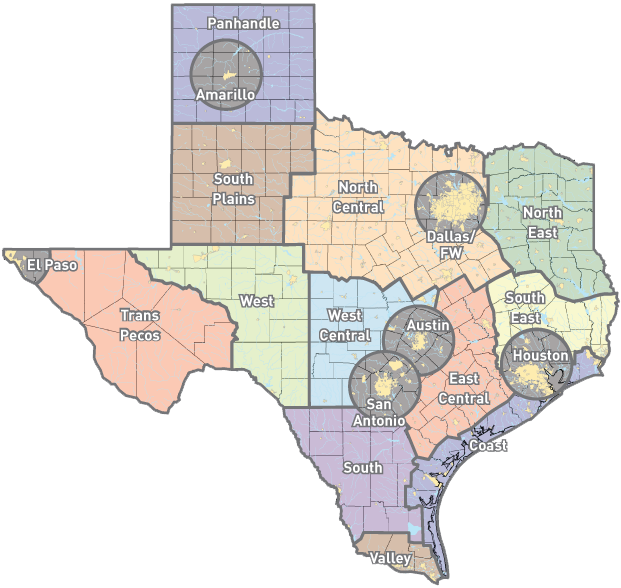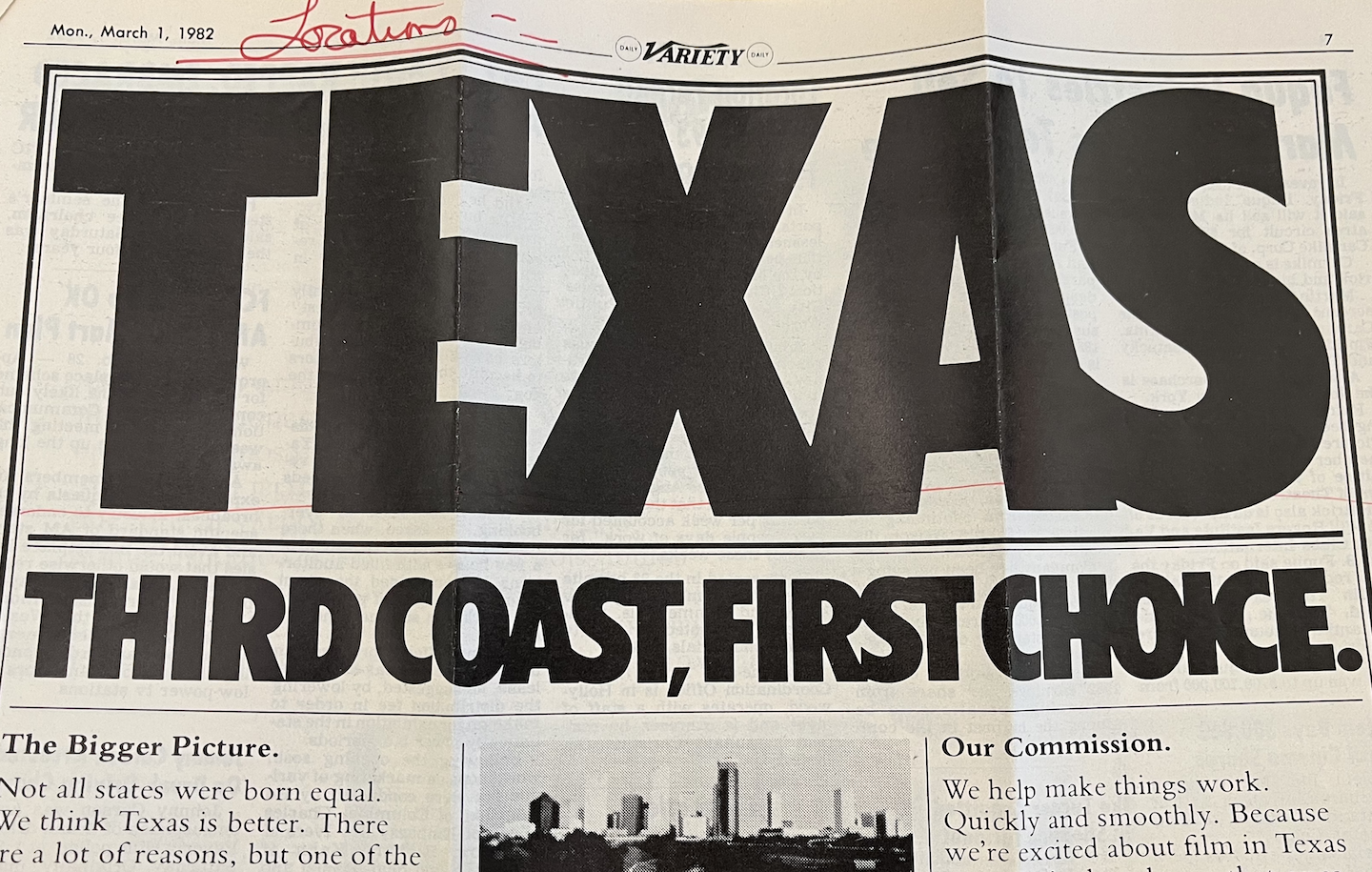The “Third Coast”: The Ebbs and Flows of Dallas’ Aspirations as a Production Hub
Jennifer Porst / Emory University

They say that everything is bigger in Texas, and that certainly applies to the aspirations of those who want to make Texas the next production hotspot. Texas is a “pro-business” state and has the 9th largest GDP in the world. It encompasses such a large geographic region that there is a huge amount of diversity between and among the different parts of the state, and that geographic diversity affords almost unlimited options for a wide variety of locations required for shooting all sorts of genres. Everything from Westerns such as Giant (1956) and True Grit (2010) have been shot in the deserts in West Texas, and football films and series like Varsity Blues (1999) and Friday Night Lights (2004, 2006-2011) have been shot in and around Austin and central Texas. Media hubs vary widely across Austin, Dallas, Fort Worth, and Houston, with Fort Worth taking the lead recently with the Taylor Sheridan production juggernaut setting up shop there.
One of the central factors in luring productions to an area are film incentives. Texas has statewide incentives and the Texas Film Commission has to then negotiate regional tensions without favoring any one area. Dallas has its own Film Commission with additional incentives and programs for productions to help it compete with other cities across the state. Those who support film incentives often promise that they will result in great financial rewards for the communities that offer them, but studies have shown that they are not as lucrative as promised. Whether or not they offer communities a good return on investment, they are successful at luring productions who want to take advantage of the financial benefits of those tax breaks and rebates. Texas’ own production booms and busts often line up with times when robust incentives have been in place, or when the appeal of more lax labor regulations in Texas as a “right to work” state has drawn productions.
In 2023, the Texas legislature debated the Texas Moving Image Industry Incentive Program (TMIIIP), which provides qualifying film, television, commercial, video game, animation, visual effects, and extended reality (AR, VR, MR) productions the opportunity to receive cash grants based on a percentage of a project’s eligible Texas Expenditures. Many Texan stars came together in a “Good For Texas” campaign that hoped to persuade Texas’ conservative legislators that Hollywood could, indeed, be good for them.
Figure 1: “Good for Texas: Supporting the Texas Film Incentives #GoodforTexas (Condensed Version)” 2023.
Other interesting incentives that Texas offers include the “Underutilized and Economically Distressed Area Incentives.” To qualify as “underutilized” an area has to receive less than 15% of the total film and television production in the state during a fiscal year. Those areas can include Houston, San Antonio, El Paso, and any other urban, suburban, or rural area more than 30 miles from Austin or Dallas City Hall. An economically distressed area of Texas is defined as an area that has a median household income that does not exceed 75% of the median state household income. Projects that complete at least 25% of their total production days or that use a basecamp in one of those areas may receive a 2.5% additional incentive to a base incentive rate. Those incentives aim to encourage productions to use locations outside of the most used and popular places in the state, and with a state as large as Texas, that includes an enormous breadth of options.
When I spoke with Stephanie Whallon, the Director of the Texas Film Commission, in 2023, she identified the variety of locations within safe driving distances of metroplexes and the incentives structured to encourage longer term productions like TV series as some of the key strengths for Texas. She said that when thinking about how to promote locations as production locations, it is important to think of them as having personalities and to identify the unique resources that each of those locations then offer. That is key to preventing the various cities in the state from competing against each other. One of the ways that the Texas Film Commission has helped locations to welcome productions was to create a Film Friendly Certificate Program, which provides cities with the resources and knowledge to create enforceable permitting guidelines, know how to take care of casts and crews who might stay in a location for an extended period of time, and help local vendors like restaurants, hotels, cleaners, etc. prepare to handle large orders and extra work.

Dallas, which is the fastest growing metroplex in the United States, is a somewhat unique location in that there is less production work on scripted fare like Hollywood films and television series, and more production work in advertising, VR/XR, sports, local broadcast, games, and some TV series – primarily reality series like Love is Blind and The Real Housewives of Dallas. In an aspirational move, Tony Armer, the Dallas Film Commissioner, recently changed the name from the Dallas Film and Creative Industries Office to the Dallas Film Commission. He explained that the change was an attempt to clarify the focus of the commission. One interesting aspect of these state and local commissions is that their function and focus is often determined by where they are located as an organization, how they receive funding, and therefore what they have as their mandates. The Dallas Film Commission, for example, is a part of Visit Dallas, which is an “independent, nor-for-profit organization that promotes Dallas as a business and pleasure destination,” as opposed to the Texas Film Commission which is a part of the Governor’s office. The Dallas Film Commission used to be a part of the City of Dallas’ Office of Arts & Culture, so even those “homes” for the commissions can change.
Echoing the rhetoric around film incentives, the film commissions argue that the work that they do drives economic growth for the city and state. Since taking over the Commission in 2023, Armer has even participated on the global stage at the European Film Market at the Berlin Film Festival and the Film USA Pavillion at the Cannes Film Festival. As you can see in the recap video, he and the Commission use those opportunities to promote Dallas as a potential location for global productions, and partners with other U.S. film commissions to promote filmmaking in America.
Figure 2: “Dallas Film Commission at Cannes: Marché du Film & Film USA Pavillion Recap!” 2024.
Just as Stephanie Whallon identified the need to develop production locations as essential, Armer has been working to address the relative lack of soundstages in Dallas and to improve the infrastructure available for productions who might be interested in shooting here for a longer duration. If we look historically, we can see that the periods when there has been a relative boom in filming in Texas, they have coincided with an increase in tax incentives alongside the development of studio space. In the early 1980s, for example, Texas was often referred to as the “Third Coast” by the trades (a moniker the state’s Film Commission was happy to promote) in part because of the enormous success of the television series Dallas and perhaps not coincidentally that coincided with labor strikes in Hollywood and producers eager to explore right to work states. In 1982, Texas developer Trammel Crow built the Studios at Las Colinas (a city located between Dallas and Fort Worth). The Studios featured two office buildings, a warehouse, and soundstages. The permanent tenants at the building offered film-related and ancillary services which, as an article in Backstage described, “enabled a visiting producer to come onto the lot with the concept, complete their project and leave with a finished product.” By 1983, they had some big name talent and productions use the facilities. For example, ABC Motion Pictures had just completed filming three months of Silkwood with Meryl Streep at the Studios. That same year, the University of Texas at Dallas held the Third Annual Motion Picture Conference with the theme: “The Future is Texas?” The answer to that question was not quite as bright as some had hoped. Dallas did not become a third coast for media production in large part because there was no significant investment in the long-term infrastructure needed to make that a reality.

One key element to a successful infrastructure is a sustainable workforce, and Whallon pointed to the need to think of locations as production ecosystems. To that end, her office works to sustain and support existing locations and laborers by developing art zones in cities as incubator spaces and making an effort in the freelance media industry to keep everyone working as much as possible. She also prioritizes developing the next generation of laborers and new locations by partnering with universities. Her office identifies the gaps in production pipelines to make sure that teachers and leaders are aware of the jobs that actually exist and can then work to prepare students for those opportunities. Armer also emphasized the importance of partnering with local film schools, so that the city can offer productions a reliable and proficient local workforce. He said he had identified a need for more training in skills needed for the roles of art department, production management, and location management in particular.
Film schools at universities around the state graduate a new class of laborers every year, and if state and local film commissions see value in working with film schools, in what ways can we partner with them that would benefit our students, our research, and the local industries? As teachers, how do we balance teaching students about the macro elements of the global media industries while also preparing them for the workforce in our local industries?
Image Credits:
- Variety article on Texas as a production location, 1982 (photo provided by author)
- “Good for Texas: Supporting the Texas Film Incentives #GoodforTexas (Condensed Version)” 2023.
- Texas Film Commission Banner Advertisement for their Film Friendly Certificate Program, 2024.
- “Dallas Film Commission at Cannes: Marché du Film & Film USA Pavillion Recap!” 2024.
“Locations-Texas (1980-1983)” clippings file in the Core Collections of the Margaret Herrick Library. Los Angeles, CA.
Swenson, Charles W. “Preliminary Evidence on Film Production and State Incentives.” Economic Development Quarterly, Vol. 31, Issue 1, 3 November 2016.